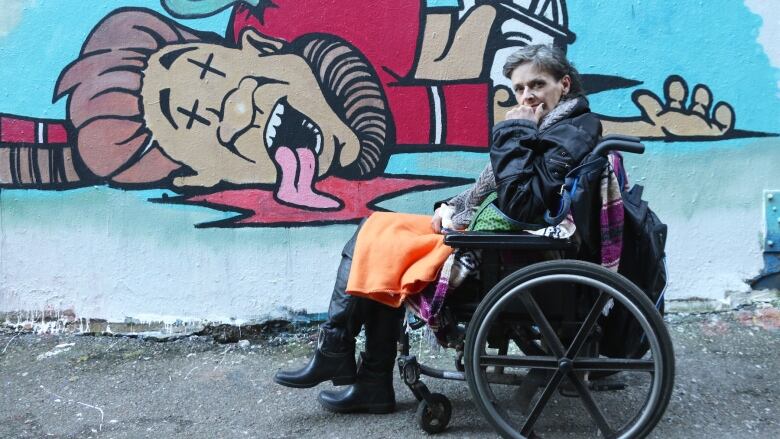Drug users share ideas to fix fentanyl crisis
'I would start with getting rid of the fentanyl,' says user. 'Ban it'

CBC News asked street drug users in Vancouver's Downtown Eastside their opinions on whatmightreduce the number of people succumbing tofatal opioid overdoses.
Give users access to clean, predictable drugs
Danielle Trudeau, 43, has been addicted to drugs for 25 years. In that time Trudeauhas overdosed about 15 times but 10 of those overdoses happened inthe past three months.
She saidtwo things could help improve the situation: access to affordable housing and access to clean, predictable drugs.
Trudeau said users have a hard time distinguishing what drugs they're consuming.
"This stuff keeps changing colour all the time, so you know, you can't keep on top of it, the stuff that's overdosing everybody," said Trudeau, who uses heroin.
"It used to be all one colour, now it's changing colour and just when we all start to get used to what dose we can take, it changes again."

Get people into housing and fund more treatment
KevinMuchikekwanape'sfour years in Vancouver's Downtown Eastside haveleft him with little hope of fixing the overdose crisis, buthehighlights a few common issues for people in his position.
Being able to afforda place to live is a challenge on welfare, he said. And then there's the difficulty getting into treatment programs.
"You can get into detox very easily," said Muchikekwanape, 42, adding that after a week of being clean, he just ends up back on the street where he started, doing heroin.
"I tried getting funding for recovery to go to a treatment centre, and I tried my [First Nations] band, Indian Affairs, I tried welfare, I tried everywhere to get funding and I couldn't get it and I wanted it," he said.

Get addiction services into small communities
Charlotte Morris, 42, came to the Downtown Eastside from the small northern B.C. community of Burns Lake. Morrissaid that there weren't enough opioid addiction treatment services there to help her.
"Bring a doctor to the small communities once a month or something, so the patients don't have to travel to the cities, because that's where the relapses are prone to happen," she said.
"It's hard for me to leave my family. I get pretty lonely and I feel like that's when I want to use, because I miss them so much," said Morris through tears. "If I'm high, I'm not thinking about my family then it's not as bad."

Get fentanyl off the streets
The biggest problem is bad drugs on the street, according to Irene Mountain, 56.
"Sometimes I worry and my husband tells me, 'Irene, it's like you're playing Russian roulette,' " Mountainsaid.
"I would start with getting rid of the fentanyl and, I know it's a pain medication, but people shouldn't use it," she said."Ban it."
Mountain saiddoctors should prescribe legal drugs to addicts who need them, and the authorities should do more to prevent illegal drugs like fentanyl from being imported to Canada.
"The RCMP and the other police are not really doing anything about this," she said.

Stop marginalizingdrug users
Daniel JamesBeaverstock, 41, is frightened by the drugs people now find on the street. Beaverstock saiddealers claim they're selling heroin with no fentanyl in it, but people keep having bad overdoses.
He hassurvived 30 overdoses, including six cardiac arrests.
But Beaverstocksaidthe marginalization of drug users is a huge contributor to the overdose crisis.
"Maybe stop making a group of people feel like they're outcasts, that they're undesirables, that they're throwaways," he said.
"Make them feel like, they too are human. You know, these are people's sons, daughters, mothers, fathers, aunts, uncles and so on," he said.
"That's what makes me want to use. Once I get into that feeling of hopelessness, then that's it. I just throw in the towel."

Change the way drug users are treated at hospitals
For Kelli Lubbers, 38, who uses heroin and methamphetamine,the problem is the lack of enforcement when it comes to keeping fentanyl out of Canada.
"I think more needs to be done on that," Lubbers said.
She added that a lot of people like her don't trust doctors and the medical system. She says people won't get things like abscesses and infections treated, because they aren't treated respectfully.
"I won't go to a hospital. Like, I will not go, unless I'm unconscious."

Provide prescription drugs for addicts
Linda Morin, 63, uses crack cocaine. Morinwants to see drugs legalized and provided by doctors, saying clean, safe substances would greatly reduce fatal overdoses.
The solution, she said, is for the government to open more places that dispense prescription opioids.
"That eliminates a lotabout the crime and dealers for that, and [it's] more, safe. Tentimes, 100, 200 times [safer]," she said.

The Fentanyl Fixis a week longseriesexploring potential solutions to B.C.'s opioid overdose crisis.
Follow Rafferty Baker on Twitter: @raffertybaker












_(720p).jpg)


 OFFICIAL HD MUSIC VIDEO.jpg)
.jpg)



























































































